Wall teichoic acid-dependent phagocytosis of intact cell walls of Lactiplantibacillus plantarum elicits IL-12 secretion from macrophages
- PMID: 36016797
- PMCID: PMC9396385
- DOI: 10.3389/fmicb.2022.986396
Wall teichoic acid-dependent phagocytosis of intact cell walls of Lactiplantibacillus plantarum elicits IL-12 secretion from macrophages
Abstract
Selected lactic acid bacteria can stimulate macrophages and dendritic cells to secrete IL-12, which plays a key role in activating innate and cellular immunity. In this study, we investigated the roles of cell wall teichoic acids (WTAs) displayed on whole intact cell walls (ICWs) of Lactiplantibacillus plantarum in activation of mouse macrophages. ICWs were prepared from whole bacterial cells of several lactobacilli without physical disruption, and thus retaining the overall shapes of the bacteria. WTA-displaying ICWs of several L. plantarum strains, but not WTA-lacking ICWs of strains of other lactobacilli, elicited IL-12 secretion from mouse bone marrow-derived macrophages (BMMs) and mouse macrophage-like J774.1 cells. The ability of the ICWs of L. plantarum to induce IL-12 secretion was abolished by selective chemical elimination of WTAs from ICWs, but was preserved by selective removal of cell wall glycopolymers other than WTAs. BMMs prepared from TLR2- or TLR4-deficient mouse could secret IL-12 upon stimulation with ICWs of L. plantarum and a MyD88 dimerization inhibitor did not affect ICW-mediated IL-12 secretion. WTA-displaying ICWs, but not WTA-lacking ICWs, were ingested in the cells within 30 min. Treatment with inhibitors of actin polymerization abolished IL-12 secretion in response to ICW stimulation and diminished ingestion of ICWs. When overall shapes of ICWs of L. plantarum were physically disrupted, the disrupted ICWs (DCWs) failed to induce IL-12 secretion. However, DCWs and soluble WTAs inhibited ICW-mediated IL-12 secretion from macrophages. Taken together, these results show that WTA-displaying ICWs of L. plantarum can elicit IL-12 production from macrophages via actin-dependent phagocytosis but TLR2 signaling axis independent pathway. WTAs displayed on ICWs are key molecules in the elicitation of IL-12 secretion, and the sizes and shapes of the ICWs have an impact on actin remodeling and subsequent IL-12 production.
Keywords: IL-12; Lactiplantibacillus plantarum; actin remodeling; cell wall teichoic acid; intact cell wall; macrophage; phogocytosis.
Copyright © 2022 Kojima, Kojima, Hosokawa, Oda, Zenke, Toura, Onohara, Yokota, Nagaoka and Kuroda.
Conflict of interest statement
The authors declare that the research was conducted in the absence of any commercial or financial relationships that could be construed as a potential conflict of interest.
Figures

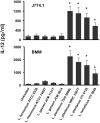
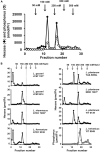

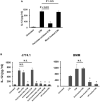
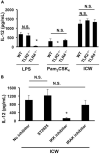
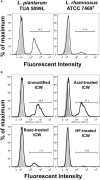



Similar articles
-
Peptidoglycan from lactobacilli inhibits interleukin-12 production by macrophages induced by Lactobacillus casei through Toll-like receptor 2-dependent and independent mechanisms.Immunology. 2009 Sep;128(1 Suppl):e858-69. doi: 10.1111/j.1365-2567.2009.03095.x. Immunology. 2009. PMID: 19740347 Free PMC article.
-
Lactobacillus plantarum possesses the capability for wall teichoic acid backbone alditol switching.Microb Cell Fact. 2012 Sep 11;11:123. doi: 10.1186/1475-2859-11-123. Microb Cell Fact. 2012. PMID: 22967304 Free PMC article.
-
Bacterial teichoic acids reverse predominant IL-12 production induced by certain lactobacillus strains into predominant IL-10 production via TLR2-dependent ERK activation in macrophages.J Immunol. 2010 Apr 1;184(7):3505-13. doi: 10.4049/jimmunol.0901569. Epub 2010 Feb 26. J Immunol. 2010. PMID: 20190136
-
The staphylococcal surface-glycopolymer wall teichoic acid (WTA) is crucial for complement activation and immunological defense against Staphylococcus aureus infection.Immunobiology. 2016 Oct;221(10):1091-101. doi: 10.1016/j.imbio.2016.06.003. Epub 2016 Jun 15. Immunobiology. 2016. PMID: 27424796 Review.
-
Wall Teichoic Acid in Staphylococcus aureus Host Interaction.Trends Microbiol. 2020 Dec;28(12):985-998. doi: 10.1016/j.tim.2020.05.017. Epub 2020 Jun 12. Trends Microbiol. 2020. PMID: 32540314 Review.
Cited by
-
Immunogenic molecules associated with gut bacterial cell walls: chemical structures, immune-modulating functions, and mechanisms.Protein Cell. 2023 Oct 25;14(10):776-785. doi: 10.1093/procel/pwad016. Protein Cell. 2023. PMID: 37013853 Free PMC article. Review.
-
Paraprobiotic derived from Bacillus velezensis GV1 improves immune response and gut microbiota composition in cyclophosphamide-treated immunosuppressed mice.Front Immunol. 2024 Feb 22;15:1285063. doi: 10.3389/fimmu.2024.1285063. eCollection 2024. Front Immunol. 2024. PMID: 38455053 Free PMC article.
-
Lactiplantibacillus plantarum LOC1 Isolated from Fresh Tea Leaves Modulates Macrophage Response to TLR4 Activation.Foods. 2022 Oct 18;11(20):3257. doi: 10.3390/foods11203257. Foods. 2022. PMID: 37431006 Free PMC article.
References
-
- Abdel-Akher M., Hamilton J. K., Montgomery R., Smith F. (1952). A new procedure for the determination of the fine structure of polysaccharides. J. Am. Chem. Soc. 74 4970–4971.
LinkOut - more resources
Full Text Sources
Research Materials

